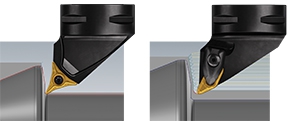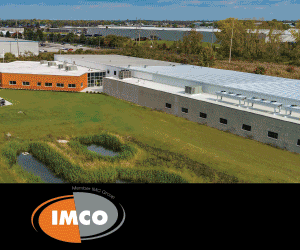Contact Details

CNC Software, Inc. has partnered with Sandvik Coromant to bring the industry’s first automated CAM support to Sandvik Coromant PrimeTurning methodology. A new set of Mastercam turning strategies, scheduled for the upcoming Mastercam 2018 release in June, supports Sandvik Coromant CoroTurn Prime inserts and the PrimeTurning technology. These automated strategies simplify CAM programming for these innovative inserts capable of increasing productivity 50-80%, achieving high material-removal rates and doubling tool life over conventional inserts currently in use.
Developers of Mastercam worked closely with the Sandvik Coromant product line management and technical specialists to implement their patent-pending PrimeTurning methodology for performing turning operations in all directions within Mastercam’s standard product. These specialized toolpath strategies take full advantage of CoroTurn Prime insert design to achieve high material-removal rates and improved tool life. Mastercam 2018 supports both CoroTurn Prime A-type inserts designed for roughing, finishing and profiling, and B-type inserts for heavy roughing applications. These automated toolpaths allow programmers to achieve high productivity gains in ISO P steels, ISO M stainless steels and ISO S heat-resistant superalloy (HRSA) materials.
“The Sandvik Coromant PrimeTurning method and new CoroTurn Prime inserts represent a game-changing development for turning, and we’re thrilled to partner with Sandvik Coromant to help bring this innovation to the market,” says Meghan West, president of CNC Software. “We are excited that our users will be some of the first to benefit from this industry breakthrough. With the widest installed base of any CAM system, we’re eager to see the many ways Mastercam users will capitalize on this ground-breaking advancement.”
”It is not very often that real innovative solutions are introduced to the Metalcutting industry. However, the PrimeTurning method is without doubt one of these things. After intense research and development and numerous testing, we can now proudly state that this is the biggest innovation in Turning … since turning," states Mia Pålsson, senior manager product unit turning tools. ”To really benefit from the huge potential, this method requires correct and smart programming. We are therefore proud to work together with CNC Software to support our common end users.”
Related Glossary Terms
- computer numerical control ( CNC)
computer numerical control ( CNC)
Microprocessor-based controller dedicated to a machine tool that permits the creation or modification of parts. Programmed numerical control activates the machine’s servos and spindle drives and controls the various machining operations. See DNC, direct numerical control; NC, numerical control.
- computer-aided manufacturing ( CAM)
computer-aided manufacturing ( CAM)
Use of computers to control machining and manufacturing processes.
- metalcutting ( material cutting)
metalcutting ( material cutting)
Any machining process used to part metal or other material or give a workpiece a new configuration. Conventionally applies to machining operations in which a cutting tool mechanically removes material in the form of chips; applies to any process in which metal or material is removed to create new shapes. See metalforming.
- profiling
profiling
Machining vertical edges of workpieces having irregular contours; normally performed with an endmill in a vertical spindle on a milling machine or with a profiler, following a pattern. See mill, milling machine.
- stainless steels
stainless steels
Stainless steels possess high strength, heat resistance, excellent workability and erosion resistance. Four general classes have been developed to cover a range of mechanical and physical properties for particular applications. The four classes are: the austenitic types of the chromium-nickel-manganese 200 series and the chromium-nickel 300 series; the martensitic types of the chromium, hardenable 400 series; the chromium, nonhardenable 400-series ferritic types; and the precipitation-hardening type of chromium-nickel alloys with additional elements that are hardenable by solution treating and aging.
- toolpath( cutter path)
toolpath( cutter path)
2-D or 3-D path generated by program code or a CAM system and followed by tool when machining a part.
- turning
turning
Workpiece is held in a chuck, mounted on a face plate or secured between centers and rotated while a cutting tool, normally a single-point tool, is fed into it along its periphery or across its end or face. Takes the form of straight turning (cutting along the periphery of the workpiece); taper turning (creating a taper); step turning (turning different-size diameters on the same work); chamfering (beveling an edge or shoulder); facing (cutting on an end); turning threads (usually external but can be internal); roughing (high-volume metal removal); and finishing (final light cuts). Performed on lathes, turning centers, chucking machines, automatic screw machines and similar machines.




